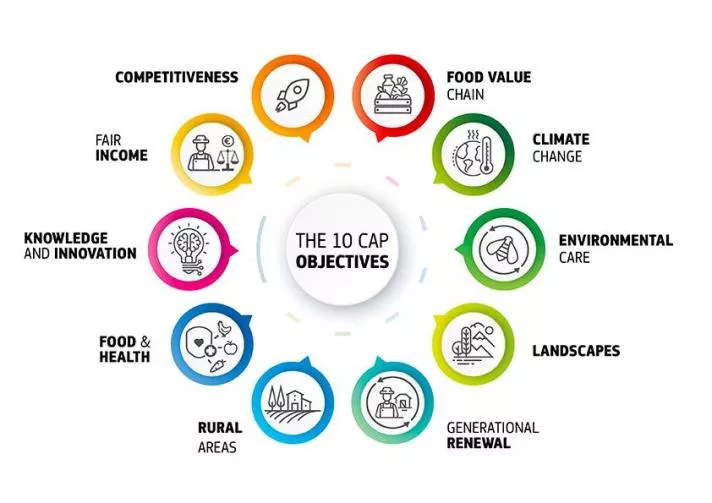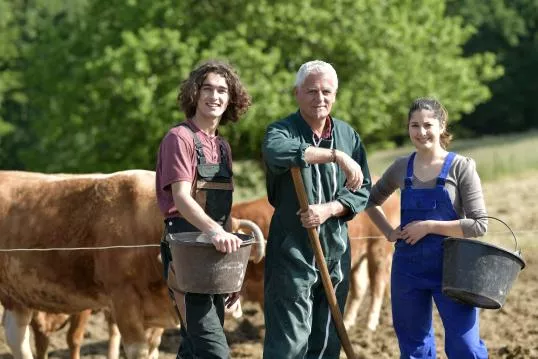
The Common Agricultural Policy
The EU’s Common Agricultural Policy (CAP) is central to the European Green Deal and its Farm to Fork and Biodiversity strategies. Today the CAP supports a modern, market-oriented farming sector providing safe, affordable, high quality food, produced sustainably and respecting consumer standards (environmental, animal welfare, food safety, etc.), as well as supporting investment in the broader rural economy. The CAP is a common policy for all EU countries, managed and funded at European level from the EU’s budget.
The CAP supports sustainable agriculture, forestry, and the development of rural areas using:
- income support through direct payments that help protect income stability for farmers who comply with environmental and social requirements;
- market ‘measures’ to help the agri-food sector deal with difficult market situations; and
- rural development ‘interventions’ addressing specific needs and challenges facing rural Europe.
A total of €386.6 billion is available for the CAP from the EU budget (2021-2027). This is divided between two funds (often referred to as the ‘two pillars’ of the CAP). These are:
- the European Agricultural Guarantee Fund (EAGF), known as Pillar 1, which provides €291.1 billion of direct financial support to farmers;
- the European Agricultural Fund for Rural Development (EAFRD), known as Pillar 2, which provides €95.5 billion (including €8.1 billion from the NextGenerationEU recovery instrument) for socio-economic and environmental interventions.
The EAGF and EAFRD are implemented through a set of legal regulations which define the CAP’s rules.
- EU Regulation 2021/2115 establishing rules on support for national CAP strategic plans;
- EU Regulation 2021/2116 on the financing, management and monitoring of the CAP;
- EU Regulation 2021/2117 on the common organisation of the agricultural markets covering quality schemes for agricultural products and geographical indications as well as measures for agriculture in the outermost regions of the EU; and
- Implementing Regulation (EU) 2021/2290 on the calculation of CAP output and result indicators.
Both the EAGF and the EAFRD are managed together by EU countries in a national CAP strategic plan. Each country’s CAP strategic plan is unique and has been designed to coordinate different CAP ‘interventions’ addressing specific needs and delivering results in relation to a set of ten CAP specific objectives.
CAP specific objectives

1. Ensuring viable farm income
Support viable farm income and the resilience of the agricultural sector across the EU in order to enhance long-term food security and agricultural diversity as well as to ensure the economic sustainability of agricultural production.
Discover more2. Increasing competitiveness: the role of productivity
Enhance market orientation and increase farm competitiveness both in the short and long term, including greater focus on research, technology and digitalisation.
Discover more3. Farmer position in value chains
Providing measures that aim to strengthen farmers’ position in a continuously evolving value chain, increase market transparency, and ensure effective mechanisms against unfair trading practices.
Discover more4. Agriculture and climate mitigation
Contribute to climate change mitigation and adaptation, including by reducing greenhouse gas emissions and enhancing carbon sequestration as well as promoting sustainable energy.
Doscover more5. Efficient soil management
Foster sustainable development and efficient management of natural resources such as water, soil and air, including by reducing chemical dependency.
Discover more6. Biodiversity and farmed landscapes
Contribute to halting and reversing biodiversity loss, enhance ecosystem services and preserve habitats and landscapes.
Discover more7. Structural change and generational renewal
Attract and sustain young farmers and new farmers and facilitate sustainable business development in rural areas.
Discover more8. Jobs and growth in rural areas
Promote employment, growth, gender equality, including the participation of women in farming, social inclusion and local development in rural areas, as well as the circular bio-economy and sustainable forestry.
Discover more9. Health, Food & Antimicrobial Resistance
Improve the response of EU agriculture to societal demands relating to food and health, including high-quality, safe and nutritious food produced in a sustainable way, to reduce food waste, as well as to improve animal welfare and combat antimicrobial resistance.
Discover more10. Driving simplification
Modernise agriculture and rural areas by fostering and sharing knowledge, innovation and digitalisation and by encouraging their uptake by farmers through improved access to research, innovation, knowledge exchange and training.
Discover moreManaging the CAP
While the European Commission bears overall responsibility for the financial management of the CAP, it does not normally make payments to beneficiaries. Most of the CAP budget is implemented under so-called ‘shared management’ between the European Commission and EU countries, with the remainder falling under ‘direct management’.
Under shared management, EU countries are responsible for setting up a management and control system for payments from the CAP strategic plans that complies with EU regulations. They must ensure that this system functions effectively and is capable of preventing, detecting and correcting irregularities.
Less than 1% of the CAP budget is managed directly by the Commission (including allocations to EU delegations and EU executive agencies). This funding provides for: administrative and technical support activities required to implement the CAP, including surveys and monitoring, audit and inspection measures, and the maintenance of agricultural accounting IT systems; promotion activities for EU agricultural products by international organisations, executive agencies and the Commission itself.
The Commission also provides grants for information measures relating to the CAP and issues contracts for third party services, such as evaluations and studies, technical assistance and training, consultancy, conferences and publicity.
The catalogue of CAP interventions in the Member States provides centralised access to all interventions and their design, in English and the original language. The database also contains data on budgets, planned output and result indicators for each intervention.

Evaluating the CAP
Policies are evaluated to determine how they perform and to help shape their future direction. For the CAP, the Performance Monitoring and Evaluation Framework (PMEF) acts as the main basis for assessing the implementation of the policy across EU Member States.
The PMEF supports the result orientation of the CAP’s New Delivery Model, under which EU Member States' performance is judged, by establishing common rules, reporting requirements and other elements necessary to assess if the policy is on track to meet its objectives, including:
- Output indicators for monitoring the implementation of the CAP;
- Result indicators to monitor the progress of EU countries towards pre-set targets; and
- Context and impact indicators to assess the overall policy performance against CAP objectives.

Evaluations are carried out by the Member States and the EU to assess the impact, effectiveness, efficiency, relevance, coherence and EU added value of the CAP. Support for a common learning process around monitoring and evaluation is provided by the European Evaluation Helpdesk for the CAP with a view to exchanging good practices among the EU Member States.